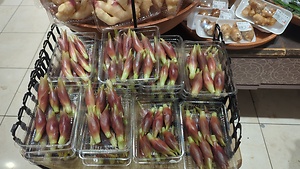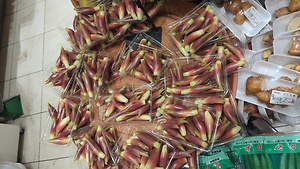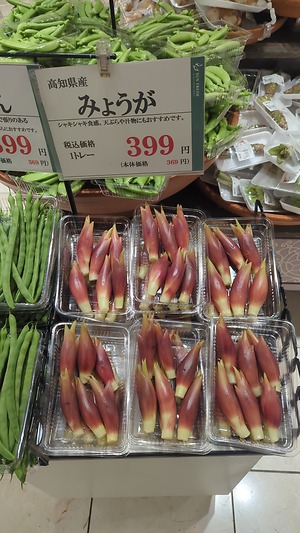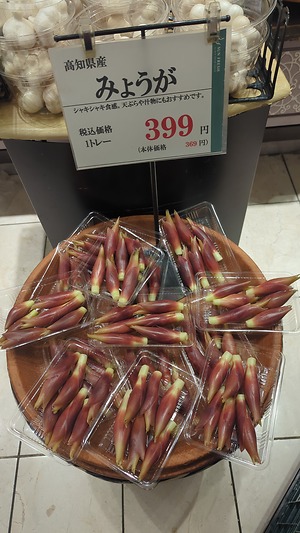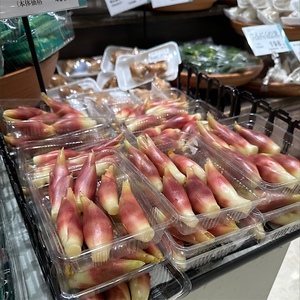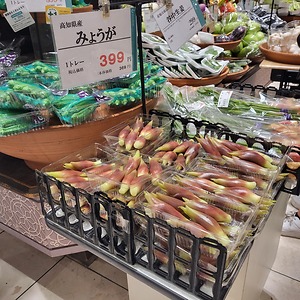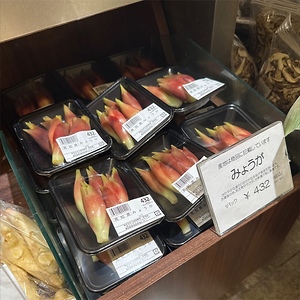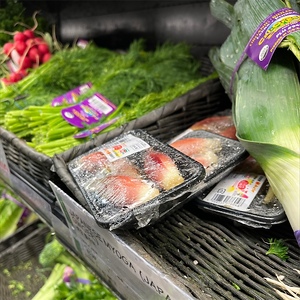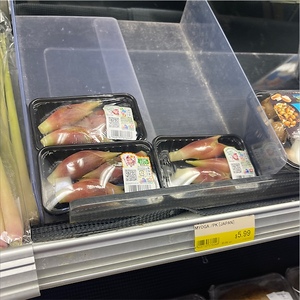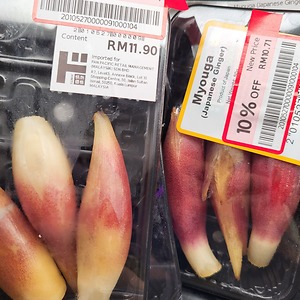


Myoga
Estimated Inventory, ea : 11.00
This item was last sold on : 07/23/25
Description/Taste
Myoga is a young flower bud of a leafy plant comprised of underground rhizomes that produce upright, above-ground pseudostems with tropical, lanceolate-shaped leaves. The flower buds grow from the rhizome and appear just above the soil, generally harvested when they reach 5 to 8 centimeters in length. The buds are slender and narrow, growing upright and showcasing a tapered, flame-like shape, ending in a point at the top of the bud. The buds are made up of multiple fleshy layers, and the bud’s surface is smooth, taut, and semi-firm, ranging in variegated hues of pink, bronze, yellow, and green. Underneath the surface, the interior of the bud is generally yellow and has a crunchy, succulent, and crisp consistency. Myoga is aromatic, reminiscent of a scallion-like scent, and the buds are edible raw or cooked. Raw Myoga has a zesty, peppery, and tangy taste with delicate onion nuances. The plant's young shoots are also edible and contain a similar flavor profile with vegetal, green qualities.
Seasons/Availability
Myoga is available year-round when grown in greenhouses. When cultivated outdoors, Myoga has a peak season in the summer through fall.
Current Facts
Myoga, botanically classified as Zingiber mioga, is the unopened flower buds of a perennial plant belonging to the Zingiberaceae family. The leafy plant can reach 45 to 60 centimeters in height, and the flower buds appear at the base of the plant, harvested before they bloom into yellow and white flowers. Myoga is native to East Asia and is also known as Rang He in China and Yang Ha in Korea. Zingiber mioga is the most cold-tolerant species of the ginger family, but unlike other gingers, it is not cultivated for its rhizome. The plant is primarily grown as an ornamental and for its edible flower buds. It is also cultivated for its young shoots known as Myoga Take. These shoots are gathered in the spring and are a seasonal delicacy, often paired with the buds in culinary dishes. Myoga is valued for its bright, refreshing, and crunchy consistency and mild, zesty flavor. The buds are favored as a garnish or are cooked like a vegetable, incorporated into raw and cooked preparations.
Nutritional Value
Myoga is a source of potassium to balance fluid levels within the body, fiber to regulate the digestive tract, and vitamin K to assist in faster wound healing. The unopened buds also provide calcium to build strong bones and teeth, manganese to develop connective tissues, and contain other nutrients, including magnesium, copper, vitamin C, iron, zinc, and B vitamins.
Applications
Myoga has a zesty, tangy, and somewhat mild flavor suited for raw and cooked preparations. The buds are traditionally consumed as a garnish and are finely shredded to create a crisp but tender consistency. Myoga can be thinly sliced and sprinkled over sushi, sashimi, and poke or delicately piled on top of noodle and rice dishes. The shredded buds can also be served with pickled items and sunomono, small plates of vinegar-infused vegetables. In addition to being used as a garnish, Myoga can be simmered into soups and broths, especially miso, or it can be sliced in half and sauteed as a vegetable. Myoga can also be battered and fried, stir-fried, or grilled to impart a savory flavor. Beyond typical preparations, Myoga is sometimes pickled as a tangy condiment or incorporated as an unusual ingredient in Japanese cocktails and desserts. Myoga pairs well with aromatics such as garlic, lemongrass, shallots, and onions, tofu, seafood, seaweed, miso, and cucumbers. Whole, unwashed Myoga should be immediately used for the best quality and flavor. Depending on the maturity of the buds, they can also be stored for a day or two in the refrigerator.
Ethnic/Cultural Info
Myoga is associated with a famous Japanese tale about a forgetful disciple of Buddha. Legend has it that the Buddha Nunn’s disciple Shuri Handk was so forgetful that he could not remember his own name. One day the Buddha decided to hang a tag with the disciple’s name around his neck so that he would not forget who he was. The disciple was initially disheartened by his forgetfulness, but as he learned from the Buddha, he eventually reached a state of enlightenment before the other disciples. After his passing, an unfamiliar plant sprouted at the disciple’s grave and was named “Myoga,” meaning “bearing or carrying a name.” In the modern-day, there is a cultural superstition that if you eat too much Myoga, you will become forgetful. Most of the time, this saying is used lightheartedly and is not taken seriously.
Geography/History
Myoga is native to East Asia, primarily Japan, China, and Korea, and has been growing wild since ancient times. The herbaceous plant thrives in rich and moist soil, commonly found on shaded forest floors, woodlands, valleys, and protected mountain slopes. Myoga typically favors humid, shaded environments, but the species is also cold tolerant, able to be grown in areas where other ginger species cannot. Historically, Myoga has been extensively cultivated as a culinary and medicinal ingredient in Japan. Some of the oldest written records of the plant were a text written during the Himiko Era and an encyclopedia written in the early Heian period known as “Honzo wa Myo.” Two Myoga buds are also used on one of Japan's ten prominent family crests. Today Myoga is found growing wild and cultivated in southern Korea, northern Vietnam, Japan, Taiwan, India, and central and southeast China. In Japan, Myoga is grown in the Kochi, Akita, Gunma, and Nara Prefectures, with the Kochi Prefecture accounting for over 80% of the Myoga produced throughout the country. Myoga has also been introduced into Australia, New Zealand, and Tasmania for commercial production, sold locally and exported to meet the demand in Japan.
Featured Restaurants
Restaurants currently purchasing this product as an ingredient for their menu.
| Lilo | Carlsbad CA | 619-385-0914 |
| Juniper & Ivy | San Diego CA | 858-481-3666 |
| Javier Plascencia (Animalon) | Bonita CA | 619-295-3172 |
| Jeune Et Jolie | Carlsbad CA | 858-231-0862 |
| Wildland Bar | Carlsbad CA | 619-385-0914 |
Recipe Ideas
Recipes that include Myoga. One



